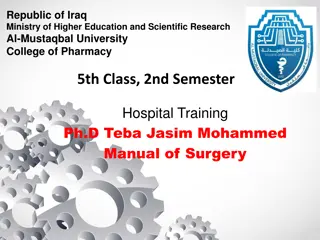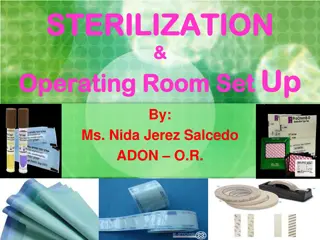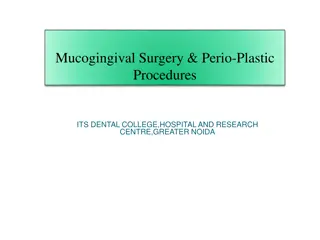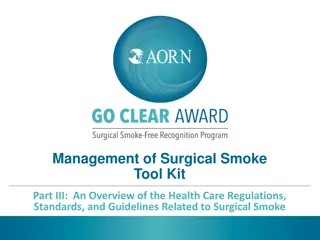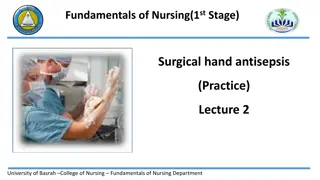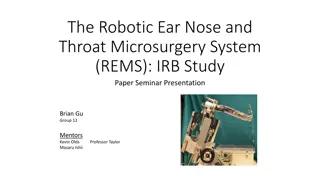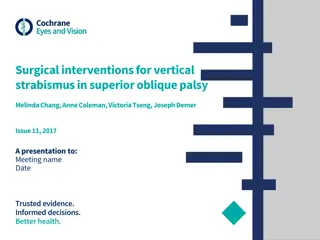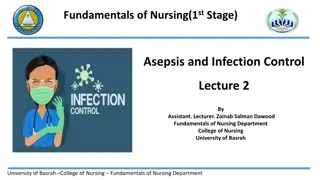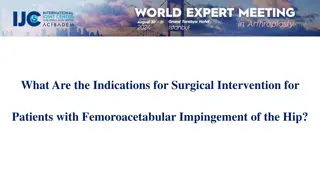Surgical Asepsis in Practice: Principles and Techniques
Surgical asepsis, also known as aseptic or sterile technique, is crucial in preventing infections during surgical procedures. This article covers the definition, introduction, and key principles of surgical asepsis, emphasizing the importance of maintaining a sterile environment to reduce the risk of contamination and improve patient outcomes in medical settings.
Download Presentation

Please find below an Image/Link to download the presentation.
The content on the website is provided AS IS for your information and personal use only. It may not be sold, licensed, or shared on other websites without obtaining consent from the author.If you encounter any issues during the download, it is possible that the publisher has removed the file from their server.
You are allowed to download the files provided on this website for personal or commercial use, subject to the condition that they are used lawfully. All files are the property of their respective owners.
The content on the website is provided AS IS for your information and personal use only. It may not be sold, licensed, or shared on other websites without obtaining consent from the author.
E N D
Presentation Transcript
StudyMafia.Org Surgical Asepsis Submitted To: Submitted By: Studymafia.org Studymafia.org
Table Contents Definition Introduction Principles of Surgical Asepsis Conclusion 2
Definition Surgical asepsis, also called aseptic/sterile technique, eliminates microorganisms before they can enter an open surgical wound or contaminate a sterile field. 3
Introduction Surgical asepsis is always practiced in operating rooms, special procedure or diagnostic areas, burn units, and in labor and delivery areas. It is also used during invasive procedures at the bedside, such as inserting chest tubes, central lines, and catheters. Surgical asepsis is one of the two types of asepsis; medical asepsis is the other. 4
Principles of Surgical Asepsis Antisepsis Prevention of sepsis by exclusion, destruction, or inhibition of growth or multiplication of microorganisms from body tissues and fluids. Asepsis Absence of microorganisms that cause disease. 6
Principles of Surgical Asepsis Antiseptics Inorganic chemical compounds that combat sepsis by inhibiting the growth of microorganisms without necessarily killing them. Used primarily on skin to stop the growth of resident flora. Aseptic technique Method to prevent contamination by microorganisms. 7
Principles of Surgical Asepsis Cross-contamination Transmission of microorganisms from patient to patient or from inanimate object to patient. Decontamination Cleaning and disinfecting or sterilizing processes carried out to make contaminated items safe to handle. Disinfection Chemical or mechanical (friction) destruction of pathogens. 8
Principles of Surgical Asepsis Barrier A material used to reduce or inhibit the migration or transmission of microorganisms in the environment: personnel attire and gowns, furniture and patient drapes, equipment and supply packaging, and ventilating filters. Contaminated Carrying or infected by microorganisms. 9
Principles of Surgical Asepsis Irreducible minimum Microbial burden cannot get any lower. Item is sterile to its highest degree. Spatial relationships Awareness of sterile, unsterile, clean, and contaminated areas, objects, and individuals and their proximity to each other. Sterile Free of living organisms. 10
Principles of Surgical Asepsis Standard precautions Procedures followed to protect personnel from contact with the blood and body fluids of patients. Sterile field Area around the site of incision into tissue or the site of introduction of an instrument into a body orifice that has been prepared using sterile supplies and equipment. 11
Principles of Surgical Asepsis Sterile technique Method by which contamination with microorganisms is prevented to maintain sterility throughout the surgical procedure. Terminal sterilization and disinfection Procedures carried out for the destruction of pathogens at the end of the surgical procedure in the operating room (OR) after the patient has been removed. 12
Conclusion Surgical asepsis is the absence of all microorganisms within any type of invasive procedure. Sterile technique is a set of specific practices and procedures performed to make equipment and areas free from all microorganisms and to maintain that sterility (BC Centre for Disease Control, 2010). 13
References Google.com Wikipedia.org Studymafia.org Slidespanda.com
Thanks To StudyMafia.org


